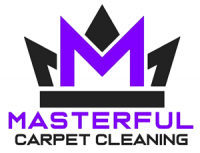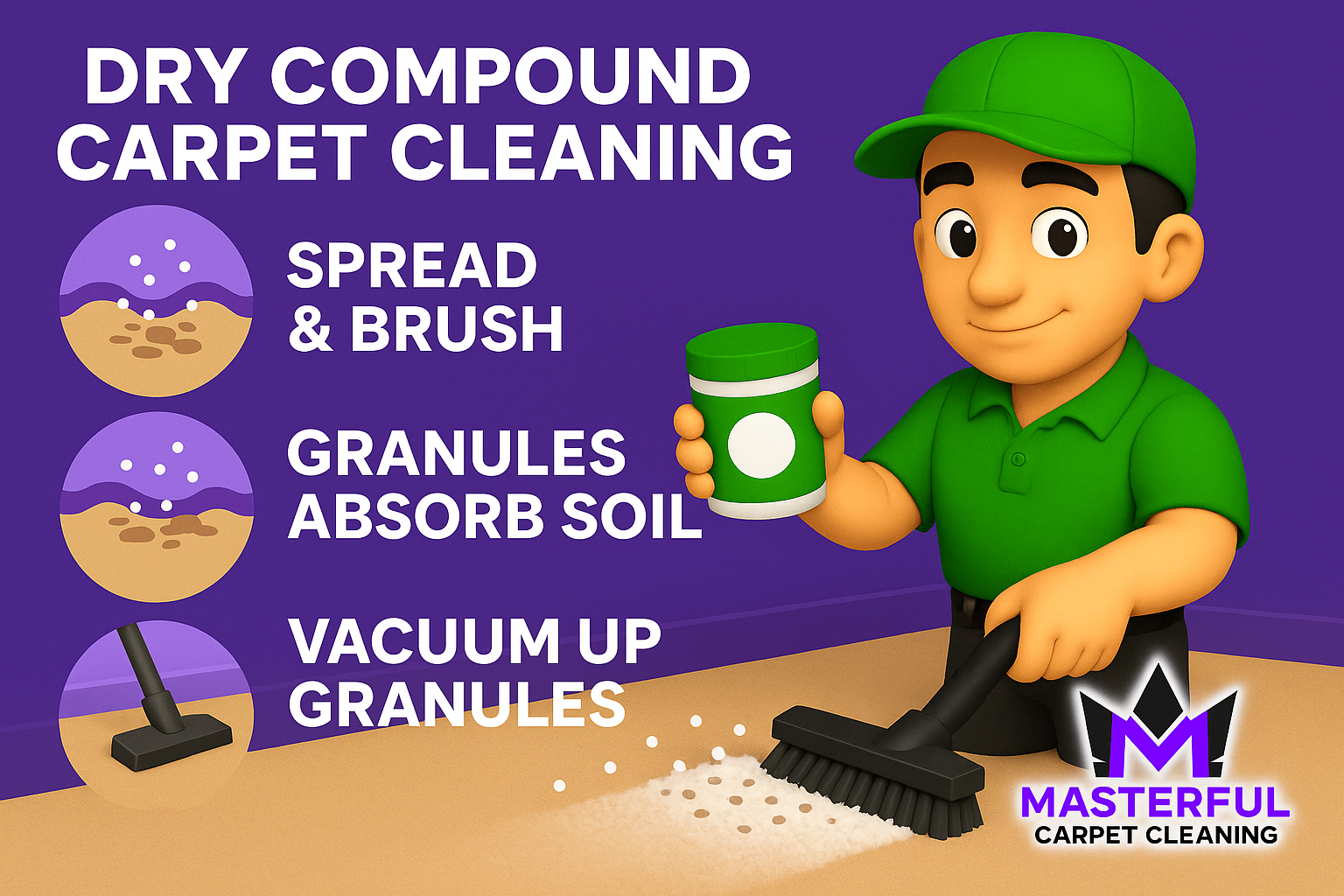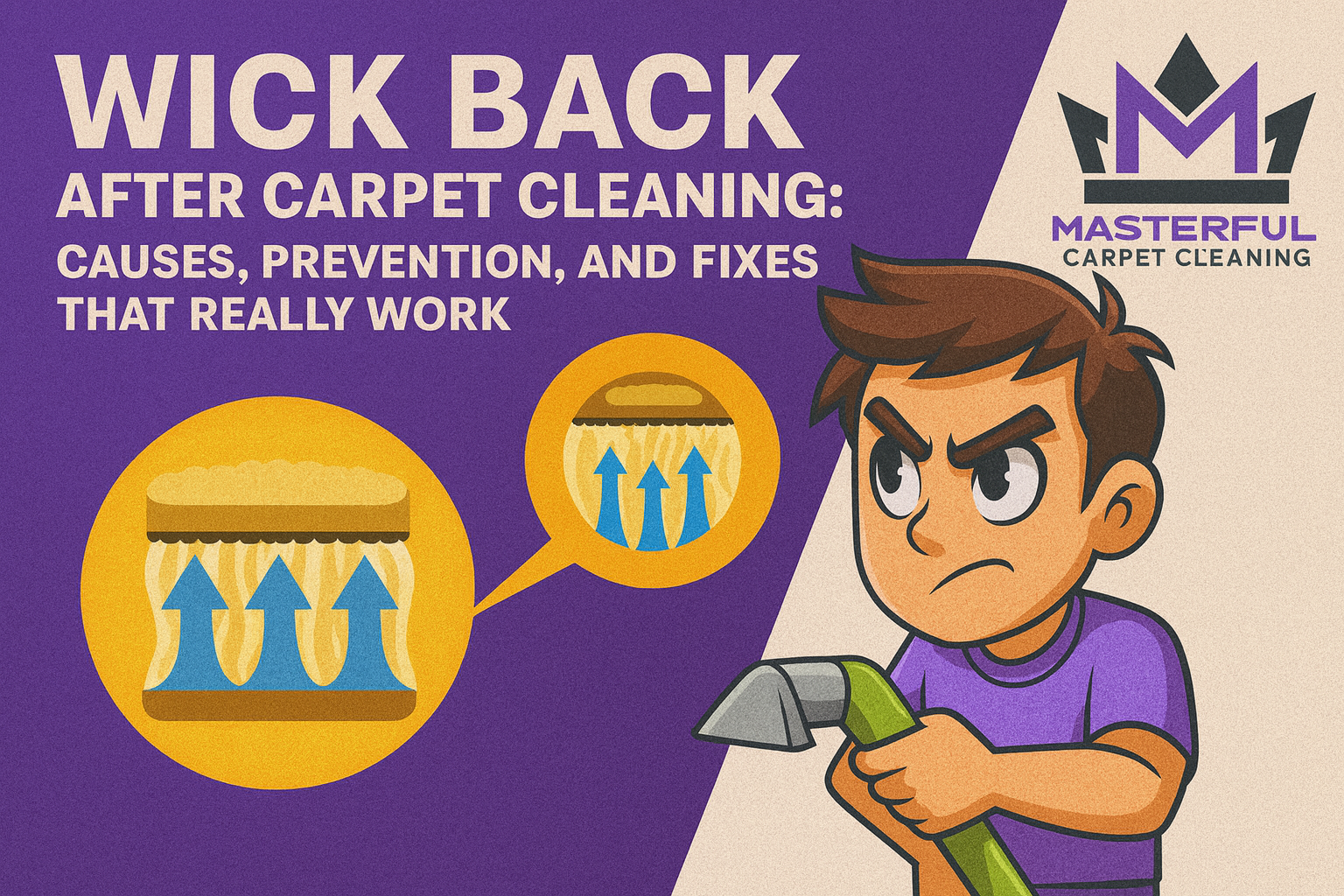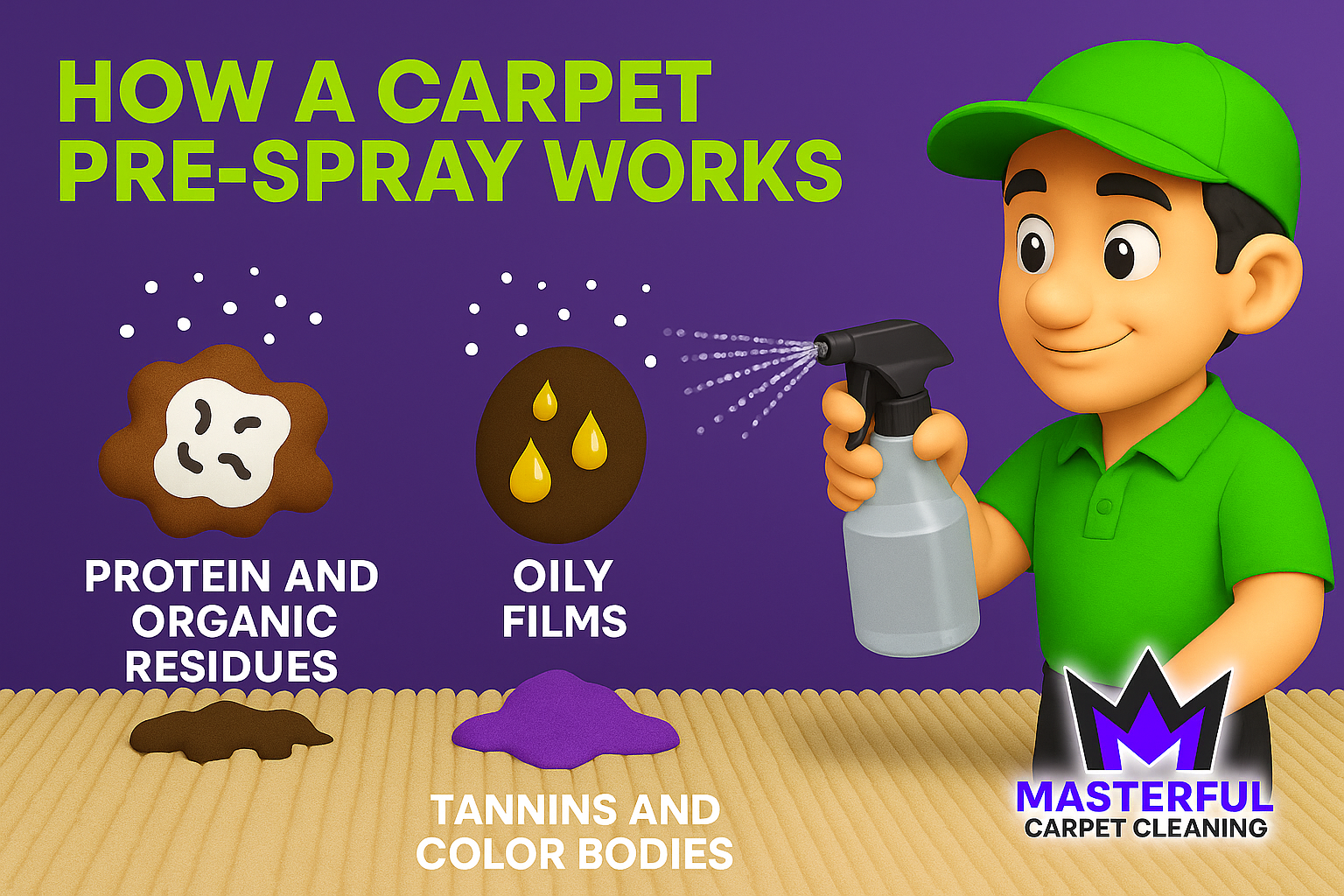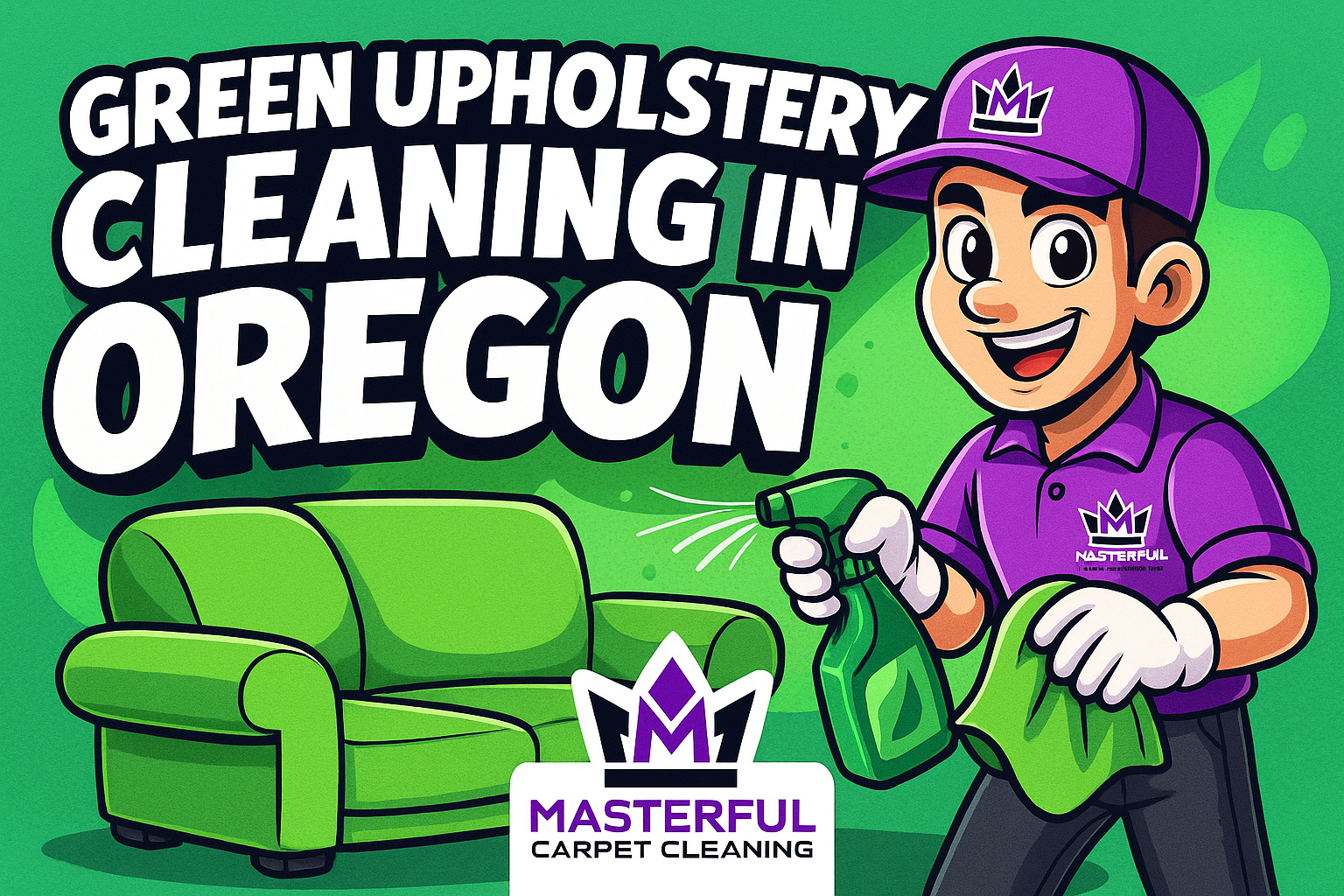Hot Water Extraction Carpet Cleaning: Process & Results
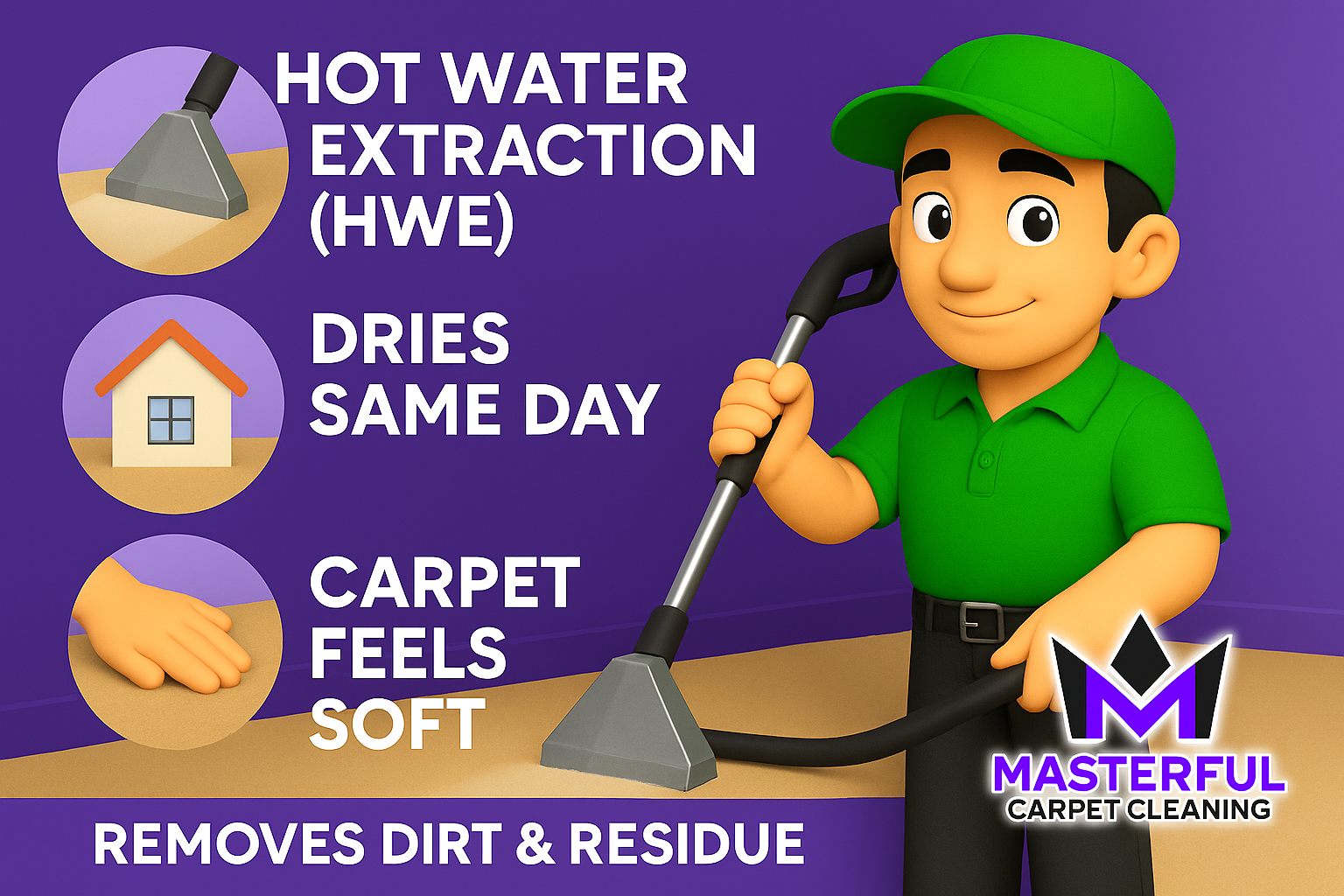
Hot Water Extraction (HWE), often called steam cleaning, uses heated water to rinse your carpet and a powerful vacuum to pull the water and soil out in the same pass. That deep rinse removes oils, grit, and sticky residues that make carpet look dull. With good airflow, most homes are dry the same day, and the carpet feels soft, not crunchy. If you’re comparing “steam cleaning” with other approaches, this side-by-side explainer helps: Carbonation Cleaning vs Steam Cleaning.
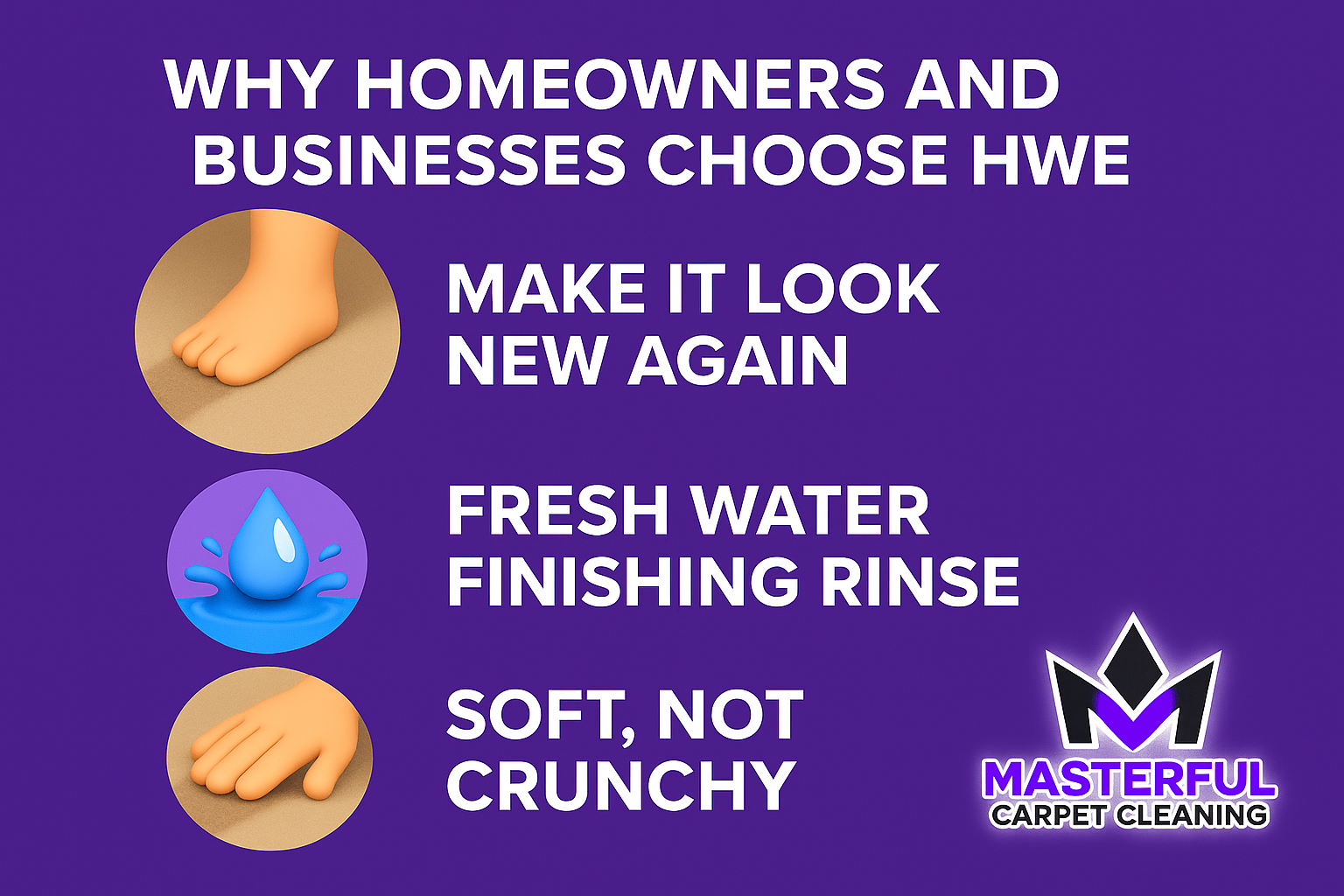
Why homeowners and businesses choose HWE
Most people book HWE when they want their carpet reset, not just freshened. The combination of heat + rinse + strong recovery takes out grime that surface methods can leave behind. You’ll also feel a difference: a fresh water finishing rinse avoids that soapy film that can cause quick re-soiling. When the goal is “make it look new again,” HWE is the right starting point. For a broader view of all the common methods, check your in-depth reference: Ultimate Guide: Carpet Cleaning Methods.
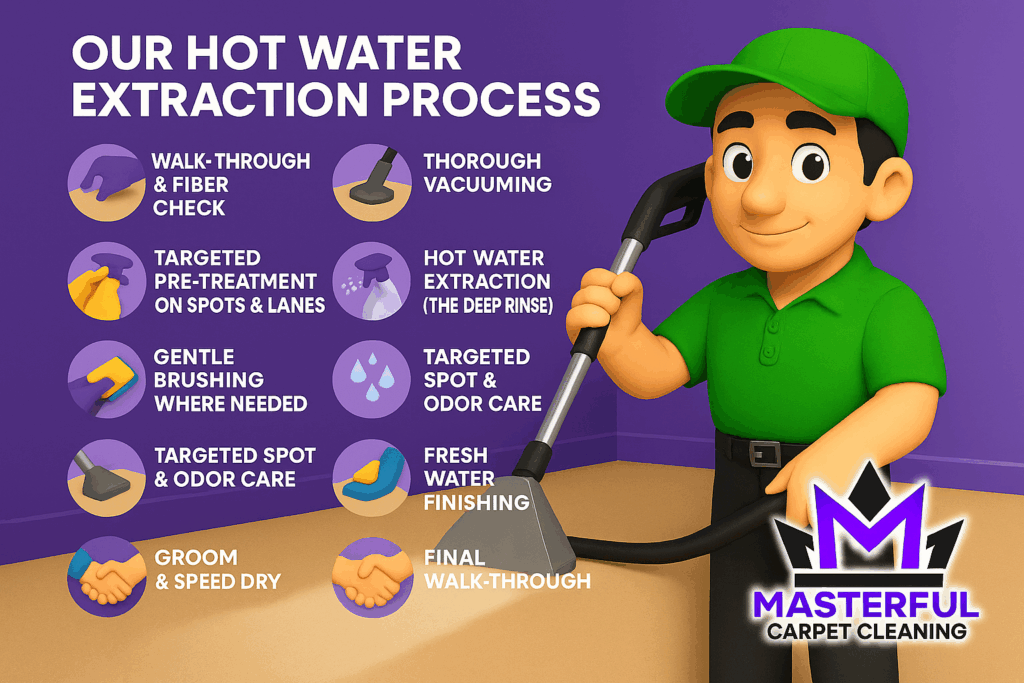
Our hot water extraction process (what we do and why it works)
Here’s how your appointment typically goes, simple and transparent:
- Walk-through & fiber check
We note traffic lanes, spots, and any delicate areas (like wool or special backings) so we choose the safest, most effective approach. - Thorough vacuuming
Dry soil comes out first. Removing grit before introducing moisture leads to a cleaner result and faster dry times. - Targeted pre-treatment on spots & lanes
We apply the right solution for the job, oils in traffic lanes, food spills, tracked in soil, so grime releases during the rinse. For a plain English explainer of the chemistry (and aftercare that helps carpets stay clean), see Carpet Cleaning Chemistry and Aftercare. Curious what each pre-spray type does? Check Carpet Pre-Sprays (Enzymatic, Solvent, Oxygenated). - Gentle brushing where needed
This helps the cleaner reach the full depth of the pile, without over wetting. - Hot water extraction (the deep rinse)
Heated water is injected and immediately recovered by high lift vacuums. That “flush-and-recover” action removes soil and leftover products from past cleanings. - Targeted spot & odor care
Coffee, dye, and pet accidents get extra attention. When urine has reached the backing or pad, we discuss deeper decontamination so the odor doesn’t return. - Fresh-water finishing rinse
This final rinse leaves fibers clean and comfortable underfoot, no sticky residue that makes carpets resoil quickly. If you’ve had “crunchy” carpet before, this is why ours feels different: No Residue Carpet Cleaning. - Groom & speed dry
We set the pile for a neat look and place air movers on busy areas to move drying along. - Final walk through
We check results together and give you simple aftercare tips, no complicated instructions, just what works.
What you’ll notice: visibly brighter traffic lanes, a fresher smell, and a soft, clean feel underfoot, without the tackiness some DIY products leave behind.
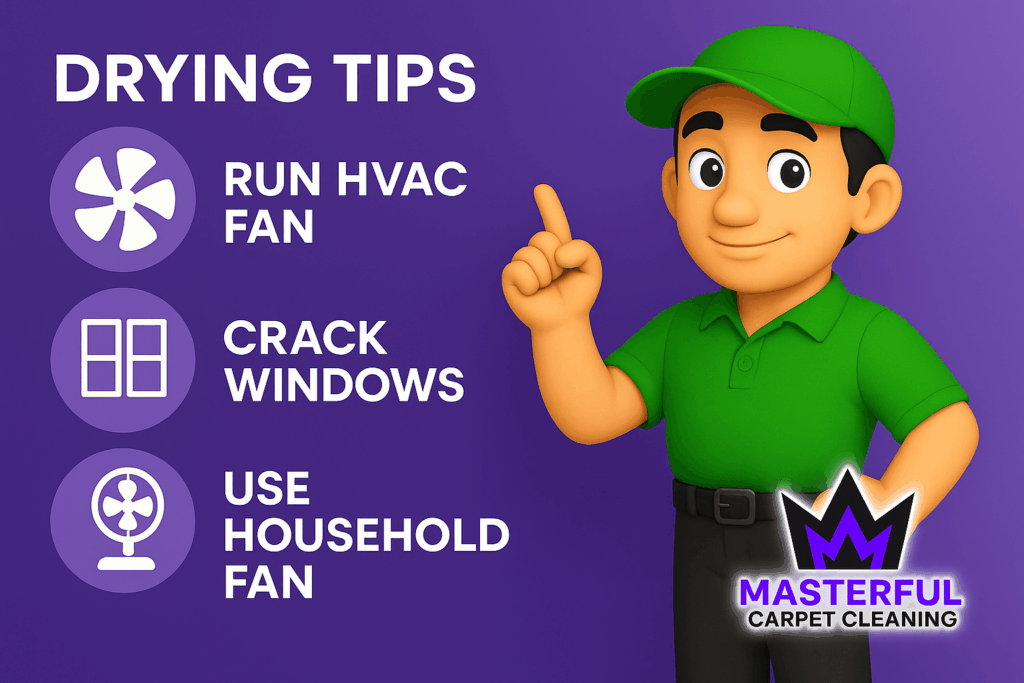
Dry time in Oregon (and how to make it faster)
Most residential carpets dry in 4-8 hours with airflow. Commercial glue down (low pile) often dries faster because there’s less fiber to hold moisture. Here in Greater Oregon – Salem, Corvallis, Eugene, McMinnville, Albany, seasonal humidity can slow evaporation a bit. That’s why we encourage you to:
- Run the HVAC fan (ON, not AUTO) for steady air movement.
- Crack a few windows when weather allows to create gentle air exchange.
- Aim a household fan down main walkways during the first hour.
- Keep furniture on tabs/blocks until everything feels dry; then remove and recycle them.
- Walk in clean socks only until dry; avoid shoes for best results.
For more on airflow and avoiding moisture issues, this article is a quick, practical read: Properly Drying Carpet: Preventing Mold & Mildew. And if you’re curious how residues affect re-soiling, here’s the deeper look: No Residue Carpet Cleaning.

When hot water extraction outperforms other methods
Choose HWE when you want a true reset:
- Heavy traffic lanes look gray or matted
A pressurized rinse lifts oils and gritty soil that make carpet look worn. For advice about tough lanes, see Best Carpet Cleaning for High Traffic Areas. - Sticky or soapy residues from DIY cleaners
HWE removes leftover product so the carpet feels clean, not tacky, and stays clean longer. More here: No Residue Carpet Cleaning. - Pet accidents and lingering odors
Deep extraction plus targeted deodorization addresses contamination below the face yarns. Learn what a complete plan looks like: Pet Odor Elimination. - Allergy relief & deep freshness
A thorough rinse-and-recover reaches deeper than surface methods. If allergies are on your mind, this explainer helps: Carpets, Indoor Air Quality & Allergies. - Before a maintenance plan
Use HWE for a restorative clean, then keep appearances sharp with quicker low-moisture visits. Planning a business schedule? See Commercial Carpet Cleaning.
When a low-moisture method is the smarter choice
Low-moisture options (like encapsulation) shine when speed and fiber care matter:
- Fast turnarounds in offices, retail, and busy homes (short dry times let you get back to normal quickly).
- Moisture-sensitive rugs or backings (e.g., certain plant fibers or jute).
- Between deep cleans, great for interim maintenance to hold appearance until the next reset.
- Color sensitive or specialty pieces that benefit from minimal wetting.
If you want the basics of how it works and when to use it, start with How Encapsulation Carpet Cleaning Works, then go deeper with Encapsulation: Benefits & Techniques and the practical budgeting angle in Low-Moisture Carpet Cleaning: Saving Time & Money.
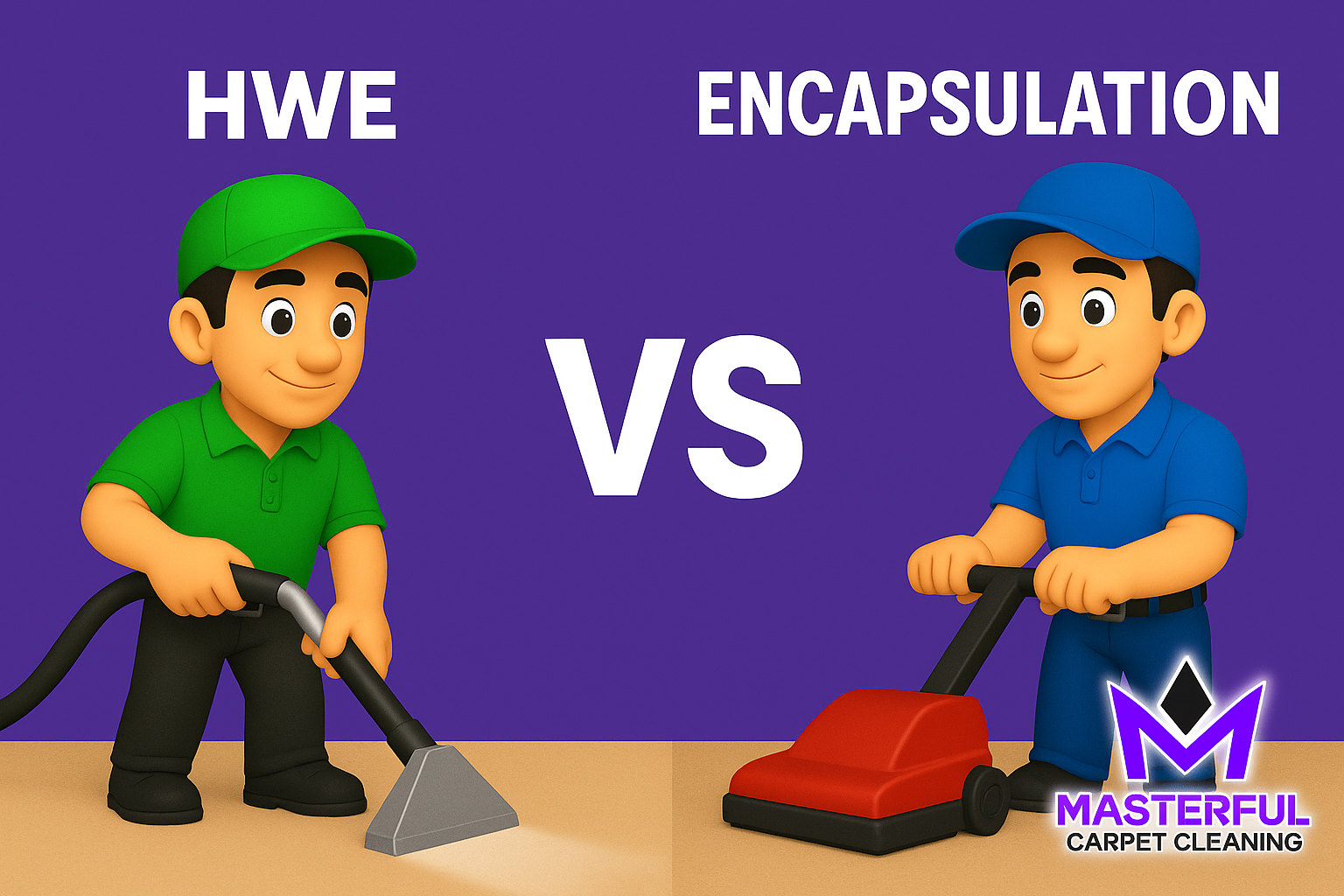
HWE vs other methods (easy comparison)
| Method | How it cleans | Residue left behind | Typical dry time | Best for |
|---|---|---|---|---|
| Hot Water Extraction (HWE) | Deep flush + powerful vacuum recovery | None when done properly | Same day | Restorative results, sticky residues, pet issues |
| Encapsulation (low-moisture) | Loosens & crystallizes soil for later vacuuming | Very low | 30-120 minutes | Quick turns, commercial maintenance, between deep cleans |
| Bonnet/OP | Pads clean the surface | Low-moderate | 1-3 hours | Fast appearance boost on looped or commercial carpet |
| Dry compound | Absorbent granules brushed in, then vacuumed | Low (with thorough vacuuming) | 30-60 minutes | Moisture sensitive areas and specialty rugs |
If you’d like the full play-by-play on methods, shortcuts, and trade offs, here’s the fuller read: Ultimate Guide: Carpet Cleaning Methods.
Real world results in Oregon (homes & businesses)
After HWE, you’ll notice:
- Brighter traffic lanes and refreshed texture, carpet looks lifted, not matted.
- Fresher smell, targeted odor work plus deep extraction tackles what surface methods miss.
- Soft, clean feel underfoot, no sticky film, so carpets stay clean longer.
- Same day dry in most homes with airflow; commercial glue down (low pile) often dries faster.
Local reality check: our wet season can slow evaporation slightly. We counter that with balanced rinse, strong recovery, and air movement so you can get back to normal the same day. If your space sees constant traffic and you want to hold that “just cleaned” look, we’ll map a schedule using low-moisture visits between restorative HWE appointments (see Commercial Carpet Cleaning for examples).
FAQs (quick, honest answers)
Is hot water extraction the same as “steam cleaning”?
People say “steam cleaning,” but professional HWE uses hot water plus powerful vacuum recovery, the rinse and recover action is what removes deep soil and residues. If you’re sorting out the jargon, this explainer helps: Carbonation Cleaning vs Steam Cleaning.
How long until it’s dry?
Most homes are 4-8 hours with ventilation; commercial glue down often faster. Run the HVAC fan, crack a few windows when weather allows, and use a small fan on main walkways (see Properly Drying Carpet: Preventing Mold & Mildew for simple steps).
Will this fix pet urine smells?
Often, yes, when paired with targeted odor treatments. If urine reached the backing or pad, we’ll discuss deeper decontamination before we clean (our approach in Pet Odor Elimination).
Is HWE safe for wool?
Yes, when temperature and pH are controlled, dyes are pre-tested, and drying is accelerated. That’s our standard process; you’ll see it reflected in our chemistry notes: Carpet Cleaning Chemistry and Aftercare.
Will my carpet resoil faster after cleaning?
Not with our finishing step. A fresh water rinse plus strong extraction leaves no sticky residue, so fibers feel soft and stay clean longer (details in No Residue Carpet Cleaning).
What about wick back after cleaning?
Most wicking is prevented by strong extraction and fast drying. If a stubborn spill reappears, light blotting and targeted treatment usually solves it, avoid soaking the area. For deeper prevention tips, see Wick Back After Carpet Cleaning – Causes, Prevention & Fixes.
How often should I schedule HWE?
Homes: every 6-12 months (more often with pets or kids). Businesses: use HWE for a restorative reset, then maintain appearance with quick low-moisture visits on a set cadence (see plan ideas in Commercial Carpet Cleaning).
Prep & aftercare
Before we arrive
- Clear small items and move breakables; we’ll advise on any heavy pieces.
- Pre-vacuum if you can, always helpful, never required.
- Point out spots, pet areas, or recent spills during the walk-through.
- Reserve a parking spot near the entry and keep a clear path for hoses/equipment.
- In wet weather, place a mat at the door; keep pets and kids away from work zones.
If you like having everything in one place, this page is handy: Appointment Checklist.
Aftercare (first 24 hours)
- Run the HVAC fan or open a few windows for airflow.
- Aim a fan down main traffic lanes for the first hour.
- Walk in clean socks only until fully dry; keep furniture on tabs/blocks until dry, then remove.
- Skip heavy spot sprays for 24 hours to minimize wick-back.
- Use caution on nearby hard floors, they can be slippery while carpet dries.
More drying tips here: Properly Drying Carpet: Preventing Mold & Mildew.
Choosing the right method (quick decision aid)
- Pick HWE when carpet looks tired, gray, or sticky, when odors linger, or when you want a clean slate before moving into a maintenance schedule. For especially beat-up lanes, this primer helps: Best Carpet Cleaning for High-Traffic Areas.
- Pick low moisture (encapsulation) when you need speed, you’re between deep cleans, or you’re dealing with moisture sensitive materials. Learn exactly how it works and when to use it: How Encapsulation Carpet Cleaning Works and Encapsulation: Benefits & Techniques, plus time/budget notes in Low Moisture Carpet Cleaning: Saving Time & Money.
As the Co-Owner of Masterful, Randy has been providing quality cleaning services to the Salem and Portland areas of Oregon for many years. He has built a reputation for excellence in the industry. His team take prides in using the latest cleaning techniques and technologies to deliver exceptional results every time. Author

